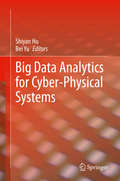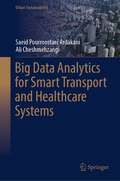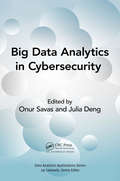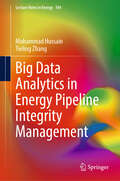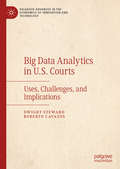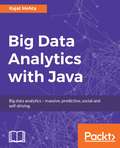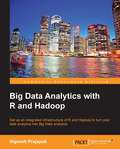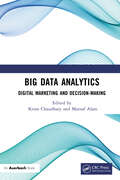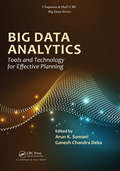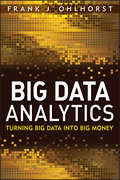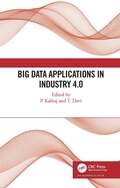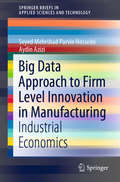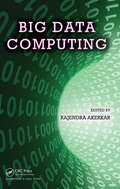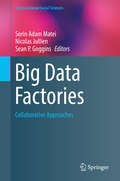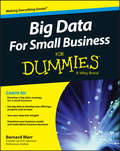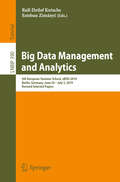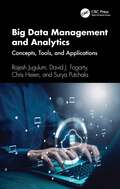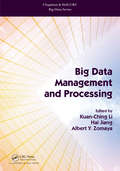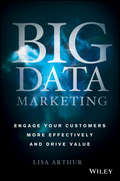- Table View
- List View
Big Data Analytics for Cyber-Physical Systems
by Bei Yu Shiyan HuThis book highlights research and survey articles dedicated to big data techniques for cyber-physical system (CPS), which addresses the close interactions and feedback controls between cyber components and physical components. The book first discusses some fundamental big data problems and solutions in large scale distributed CPSs. The book then addresses the design and control challenges in multiple CPS domains such as vehicular system, smart city, smart building, and digital microfluidic biochips. This book also presents the recent advances and trends in the maritime simulation system and the flood defence system.
Big Data Analytics for Smart Transport and Healthcare Systems (Urban Sustainability)
by Ali Cheshmehzangi Saeid Pourroostaei ArdakaniThis book aims to introduce big data solutions in urban sustainability applications—mainly smart transportation and healthcare systems. It focuses on machine learning techniques and data processing approaches which have the capacity to handle/process huge, live, and complex datasets in real-time transportation and healthcare applications. For this, several state-of-the-art data processing approaches including data pre-processing, classification, regression, and clustering are introduced, tested, and evaluated to highlight their benefits and constraints where data is sensitive, real-time, and/or semi-structured.
Big Data Analytics in Cybersecurity (Data Analytics Applications)
by Onur Savas Julia DengBig data is presenting challenges to cybersecurity. For an example, the Internet of Things (IoT) will reportedly soon generate a staggering 400 zettabytes (ZB) of data a year. Self-driving cars are predicted to churn out 4000 GB of data per hour of driving. Big data analytics, as an emerging analytical technology, offers the capability to collect, store, process, and visualize these vast amounts of data. Big Data Analytics in Cybersecurity examines security challenges surrounding big data and provides actionable insights that can be used to improve the current practices of network operators and administrators. Applying big data analytics in cybersecurity is critical. By exploiting data from the networks and computers, analysts can discover useful network information from data. Decision makers can make more informative decisions by using this analysis, including what actions need to be performed, and improvement recommendations to policies, guidelines, procedures, tools, and other aspects of the network processes. Bringing together experts from academia, government laboratories, and industry, the book provides insight to both new and more experienced security professionals, as well as data analytics professionals who have varying levels of cybersecurity expertise. It covers a wide range of topics in cybersecurity, which include: Network forensics Threat analysis Vulnerability assessment Visualization Cyber training. In addition, emerging security domains such as the IoT, cloud computing, fog computing, mobile computing, and cyber-social networks are examined. The book first focuses on how big data analytics can be used in different aspects of cybersecurity including network forensics, root-cause analysis, and security training. Next it discusses big data challenges and solutions in such emerging cybersecurity domains as fog computing, IoT, and mobile app security. The book concludes by presenting the tools and datasets for future cybersecurity research.
Big Data Analytics in Energy Pipeline Integrity Management (Lecture Notes in Energy #104)
by Muhammad Hussain Tieling ZhangThis book offers a comprehensive exploration of the integration of Big Data analytics into the management of energy pipeline integrity. Its primary aim is to enhance pipeline safety, reduce operational costs, and ensure long-term sustainability by leveraging data-driven technologies in the monitoring and maintenance of pipelines. Aimed at professionals and researchers in the energy, oil, and gas sectors, as well as those involved in infrastructure management and data science, the book presents how emerging technologies, such as Big Data, Machine Learning (ML), Internet of Things (IoT), and Artificial Intelligence (AI), can revolutionize pipeline integrity management systems (PIMS).
Big Data Analytics in U.S. Courts: Uses, Challenges, and Implications (Palgrave Advances in the Economics of Innovation and Technology)
by Dwight Steward Roberto CavazosThis Palgrave Pivot identifies the key legal, economic, and policy issues surrounding the allowance to use and interpret electronic data consistently and in a scientifically valid manner in U.S. courts. Evidence based on the analysis of large amounts of electronic data ("Big Data") plays an increasing role in civil court disputes, providing information that could not have been obtained from a witness stand. While Big Data evidence presents opportunities, it also presents legal and public policy challenges and concerns. How can one be sure that deviations found in Big Data fall outside the norm? If statistical analyses can be conducted and presented different ways, how can judges and juries make sense of conflicting interpretations? When does Big Data extraction stop being investigative and instead become an invasion of privacy? This book traces the history of Big Data use in U.S. courts, couples current case studies with legal challenges to explore key controversies, and suggests how courts can change the way they handle Big Data to ensure that findings are statistically significant and scientifically sound.
Big Data Analytics with Java
by Rajat MehtaLearn the basics of analytics on big data using Java, machine learning and other big data tools About This Book • Acquire real-world set of tools for building enterprise level data science applications • Surpasses the barrier of other languages in data science and learn create useful object-oriented codes • Extensive use of Java compliant big data tools like apache spark, Hadoop, etc. Who This Book Is For This book is for Java developers who are looking to perform data analysis in production environment. Those who wish to implement data analysis in their Big data applications will find this book helpful. What You Will Learn • Start from simple analytic tasks on big data • Get into more complex tasks with predictive analytics on big data using machine learning • Learn real time analytic tasks • Understand the concepts with examples and case studies • Prepare and refine data for analysis • Create charts in order to understand the data • See various real-world datasets In Detail This book covers case studies such as sentiment analysis on a tweet dataset, recommendations on a movielens dataset, customer segmentation on an ecommerce dataset, and graph analysis on actual flights dataset. This book is an end-to-end guide to implement analytics on big data with Java. Java is the de facto language for major big data environments, including Hadoop. This book will teach you how to perform analytics on big data with production-friendly Java. This book basically divided into two sections. The first part is an introduction that will help the readers get acquainted with big data environments, whereas the second part will contain a hardcore discussion on all the concepts in analytics on big data. It will take you from data analysis and data visualization to the core concepts and advantages of machine learning, real-life usage of regression and classification using Naive Bayes, a deep discussion on the concepts of clustering,and a review of simple neural networks on big data using deepLearning4j or plain Java Spark code. This book is a must-have book for Java developers who want to start learning big data analytics and want to use it in the real world. Style and approach The approach of book is to deliver practical learning modules in manageable content. Each chapter is a self-contained unit of a concept in big data analytics. Book will step by step builds the competency in the area of big data analytics. Examples using real world case studies to give ideas of real applications and how to use the techniques mentioned. The examples and case studies will be shown using both theory and code.
Big Data Analytics with R and Hadoop
by Vignesh PrajapatiBig Data Analytics with R and Hadoop is a tutorial style book that focuses on all the powerful big data tasks that can be achieved by integrating R and Hadoop.This book is ideal for R developers who are looking for a way to perform big data analytics with Hadoop. This book is also aimed at those who know Hadoop and want to build some intelligent applications over Big data with R packages. It would be helpful if readers have basic knowledge of R.
Big Data Analytics with SAS
by David PopeLeverage the capabilities of SAS to process and analyze Big Data About This Book • Combine SAS with platforms such as Hadoop, SAP HANA, and Cloud Foundry-based platforms for effecient Big Data analytics • Learn how to use the web browser-based SAS Studio and iPython Jupyter Notebook interfaces with SAS • Practical, real-world examples on predictive modeling, forecasting, optimizing and reporting your Big Data analysis with SAS Who This Book Is For SAS professionals and data analysts who wish to perform analytics on Big Data using SAS to gain actionable insights will find this book to be very useful. If you are a data science professional looking to perform large-scale analytics with SAS, this book will also help you. A basic understanding of SAS will be helpful, but is not mandatory. What You Will Learn • Configure a free version of SAS in order do hands-on exercises dealing with data management, analysis, and reporting. • Understand the basic concepts of the SAS language which consists of the data step (for data preparation) and procedures (or PROCs) for analysis. • Make use of the web browser based SAS Studio and iPython Jupyter Notebook interfaces for coding in the SAS, DS2, and FedSQL programming languages. • Understand how the DS2 programming language plays an important role in Big Data preparation and analysis using SAS • Integrate and work efficiently with Big Data platforms like Hadoop, SAP HANA, and cloud foundry based systems. In Detail SAS has been recognized by Money Magazine and Payscale as one of the top business skills to learn in order to advance one's career. Through innovative data management, analytics, and business intelligence software and services, SAS helps customers solve their business problems by allowing them to make better decisions faster. This book introduces the reader to the SAS and how they can use SAS to perform efficient analysis on any size data, including Big Data. The reader will learn how to prepare data for analysis, perform predictive, forecasting, and optimization analysis and then deploy or report on the results of these analyses. While performing the coding examples within this book the reader will learn how to use the web browser based SAS Studio and iPython Jupyter Notebook interfaces for working with SAS. Finally, the reader will learn how SAS's architecture is engineered and designed to scale up and/or out and be combined with the open source offerings such as Hadoop, Python, and R. By the end of this book, you will be able to clearly understand how you can efficiently analyze Big Data using SAS. Style and approach The book starts off by introducing the reader to SAS and the SAS programming language which provides data management, analytical, and reporting capabilities. Most chapters include hands on examples which highlights how SAS provides The Power to Know©. The reader will learn that if they are looking to perform large-scale data analysis that SAS provides an open platform engineered and designed to scale both up and out which allows the power of SAS to combine with open source offerings such as Hadoop, Python, and R.
Big Data Analytics: A Social Network Approach (Studies in Big Data #30)
by Ajith Abraham Mrutyunjaya Panda Aboul HassanienSocial networking has increased drastically in recent years, resulting in an increased amount of data being created daily. Furthermore, diversity of issues and complexity of the social networks pose a challenge in social network mining. Traditional algorithm software cannot deal with such complex and vast amounts of data, necessitating the development of novel analytic approaches and tools. This reference work deals with social network aspects ofbig data analytics. It covers theory, practices and challenges in social networking. The book spans numerous disciplines like neural networking, deep learning, artificial intelligence, visualization, e-learning in higher education, e-healthcare, security and intrusion detection.
Big Data Analytics: Applications in Business and Marketing
by Mansaf Alam Kiran ChaudharyBig Data Analytics: Applications in Business and Marketing explores the concepts and applications related to marketing and business as well as future research directions. It also examines how this emerging field could be extended to performance management and decision-making. Investment in business and marketing analytics can create value through proper allocation of resources and resource orchestration process. The use of data analytics tools can be used to diagnose and improve performance. The book is divided into five parts. The first part introduces data science, big data, and data analytics. The second part focuses on applications of business analytics including: Big data analytics and algorithm Market basket analysis Anticipating consumer purchase behavior Variation in shopping patterns Big data analytics for market intelligence The third part looks at business intelligence and features an evaluation study of churn prediction models for business Intelligence. The fourth part of the book examines analytics for marketing decision-making and the roles of big data analytics for market intelligence and of consumer behavior. The book concludes with digital marketing, marketing by consumer analytics, web analytics for digital marketing, and smart retailing. This book covers the concepts, applications and research trends of marketing and business analytics with the aim of helping organizations increase profitability by improving decision-making through data analytics.
Big Data Analytics: Digital Marketing and Decision-Making
by Mansaf Alam Kiran ChaudharyBig Data Analytics: Digital Marketing and Decision-Making covers the advances related to marketing and business analytics. Investment marketing analytics can create value through proper allocation of resources and resource orchestration processes. The use of data analytics tools can be used to improve and speed decision-making processes. Chapters examining analytics for decision-making cover such topics as: Big data analytics for gathering business intelligence Data analytics and consumer behavior The role of big data analytics in organizational decision-making This book also looks at digital marketing and focuses on such areas as: The prediction of marketing by consumer analytics Web analytics for digital marketing Smart retailing Leveraging web analytics for optimizing digital marketing strategies Big Data Analytics: Digital Marketing and Decision-Making aims to help organizations increase their profits by making better decisions on time through the use of data analytics. It is written for students, practitioners, industry professionals, researchers, and faculty working in the field of commerce and marketing, big data analytics, and organizational decision-making.
Big Data Analytics: Tools and Technology for Effective Planning (Chapman & Hall/CRC Big Data Series)
by Ganesh Chandra Deka Arun K. SomaniThe proposed book will discuss various aspects of big data Analytics. It will deliberate upon the tools, technology, applications, use cases and research directions in the field. Chapters would be contributed by researchers, scientist and practitioners from various reputed universities and organizations for the benefit of readers.
Big Data Analytics: Turning Big Data into Big Money (Wiley and SAS Business Series #65)
by Frank J. OhlhorstUnique insights to implement big data analytics and reap big returns to your bottom line Focusing on the business and financial value of big data analytics, respected technology journalist Frank J. Ohlhorst shares his insights on the newly emerging field of big data analytics in Big Data Analytics. This breakthrough book demonstrates the importance of analytics, defines the processes, highlights the tangible and intangible values and discusses how you can turn a business liability into actionable material that can be used to redefine markets, improve profits and identify new business opportunities. Reveals big data analytics as the next wave for businesses looking for competitive advantage Takes an in-depth look at the financial value of big data analytics Offers tools and best practices for working with big data Once the domain of large on-line retailers such as eBay and Amazon, big data is now accessible by businesses of all sizes and across industries. From how to mine the data your company collects, to the data that is available on the outside, Big Data Analytics shows how you can leverage big data into a key component in your business's growth strategy.
Big Data Applications in Industry 4.0
by P. KalirajIndustry 4.0 is the latest technological innovation in manufacturing with the goal to increase productivity in a flexible and efficient manner. Changing the way in which manufacturers operate, this revolutionary transformation is powered by various technology advances including Big Data analytics, Internet of Things (IoT), Artificial Intelligence (AI), and cloud computing. Big Data analytics has been identified as one of the significant components of Industry 4.0, as it provides valuable insights for smart factory management. Big Data and Industry 4.0 have the potential to reduce resource consumption and optimize processes, thereby playing a key role in achieving sustainable development. Big Data Applications in Industry 4.0 covers the recent advancements that have emerged in the field of Big Data and its applications. The book introduces the concepts and advanced tools and technologies for representing and processing Big Data. It also covers applications of Big Data in such domains as financial services, education, healthcare, biomedical research, logistics, and warehouse management. Researchers, students, scientists, engineers, and statisticians can turn to this book to learn about concepts, technologies, and applications that solve real-world problems. Features An introduction to data science and the types of data analytics methods accessible today An overview of data integration concepts, methodologies, and solutions A general framework of forecasting principles and applications, as well as basic forecasting models including naïve, moving average, and exponential smoothing models A detailed roadmap of the Big Data evolution and its related technological transformation in computing, along with a brief description of related terminologies The application of Industry 4.0 and Big Data in the field of education The features, prospects, and significant role of Big Data in the banking industry, as well as various use cases of Big Data in banking, finance services, and insurance Implementing a Data Lake (DL) in the cloud and the significance of a data lake in decision making
Big Data Approach to Firm Level Innovation in Manufacturing: Industrial Economics (SpringerBriefs in Applied Sciences and Technology)
by Aydin Azizi Seyed Mehrshad Parvin HosseiniThis book discusses utilizing Big Data and Machine Learning approaches in investigating five aspects of firm level innovation in manufacturing; (1) factors that determine the decision to innovate (2) the extent of innovation (3) characteristics of an innovating firm (4) types of innovation undertaken and (5) the factors that drive and enable different types of innovation. A conceptual model and a cost-benefit framework were developed to explain a firm’s decision to innovate. To empirically demonstrate these aspects, Big data and machine learning approaches were introduced in the form of a case study. The result of Big data analysis as an inferior method to analyse innovation data was also compared with the results of conventional statistical methods. The implications of the findings of the study for increasing the pace of innovation are also discussed.
Big Data Computing
by Rajendra AkerkarDue to market forces and technological evolution, Big Data computing is developing at an increasing rate. A wide variety of novel approaches and tools have emerged to tackle the challenges of Big Data, creating both more opportunities and more challenges for students and professionals in the field of data computation and analysis. Presenting a mix
Big Data Computing: A Guide for Business and Technology Managers (Chapman & Hall/CRC Big Data Series)
by Vivek KaleThis book unravels the mystery of Big Data computing and its power to transform business operations. The approach it uses will be helpful to any professional who must present a case for realizing Big Data computing solutions or to those who could be involved in a Big Data computing project. It provides a framework that enables business and technical managers to make optimal decisions necessary for the successful migration to Big Data computing environments and applications within their organizations.
Big Data Factories: Collaborative Approaches (Computational Social Sciences)
by Sean P. Goggins Sorin Adam Matei Nicolas JullienThe book proposes a systematic approach to big data collection, documentation and development of analytic procedures that foster collaboration on a large scale. This approach, designated as "data factoring" emphasizes the need to think of each individual dataset developed by an individual project as part of a broader data ecosystem, easily accessible and exploitable by parties not directly involved with data collection and documentation. Furthermore, data factoring uses and encourages pre-analytic operations that add value to big data sets, especially recombining and repurposing. The book proposes a research-development agenda that can undergird an ideal data factory approach. Several programmatic chapters discuss specialized issues involved in data factoring (documentation, meta-data specification, building flexible, yet comprehensive data ontologies, usability issues involved in collaborative tools, etc. ). The book also presents case studies for data factoring and processing that can lead to building better scientific collaboration and data sharing strategies and tools. Finally, the book presents the teaching utility of data factoring and the ethical and privacy concerns related to it. Chapter 9 of this book is available open access under a CC BY 4. 0 license at link. springer. com
Big Data Finance in China (Contributions to Finance and Accounting)
by Wei Chen Wenting Zhang Mengyao LinThis book starts by introducing the background of the era of data elements, clarifies the theoretical basis and technical methods related to big data, and analyzes the specific application of big data technology in China’s banking industry, the insurance industry, securities investment industry, third-party payment, risk supervision, and other fields. application, and thereby finally summarize useful experiences for big data development as well as effective regulation and supervision. We hope that this book can help with subsequent research and application of big data technology in the financial field. This book has a broad audience, especially scholars and practitioners. It is a valuable reference for researchers in related fields, and it can also provide some insights into financial regulators’ awareness of big data finance. Furthermore, it aids in formulating and improving consumption policies, adjusting economic structures, and preventing risks under financial innovation. This research provides valuable guidance for improving financial innovation as well as the effective regulation thereon by financial regulators.
Big Data For Small Business For Dummies
by Bernard MarrCapitalise on big data to add value to your small business Written by bestselling author and big data expert Bernard Marr, Big Data For Small Business For Dummies helps you understand what big data actually is--and how you can analyse and use it to improve your business. Free of confusing jargon and complemented with lots of step-by-step guidance and helpful advice, it quickly and painlessly helps you get the most from using big data in a small business. Business data has been around for a long time. Unfortunately, it was trapped away in overcrowded filing cabinets and on archaic floppy disks. Now, thanks to technology and new tools that display complex databases in a much simpler manner, small businesses can benefit from the big data that's been hiding right under their noses. With the help of this friendly guide, you'll discover how to get your hands on big data to develop new offerings, products and services; understand technological change; create an infrastructure; develop strategies; and make smarter business decisions. Shows you how to use big data to make sense of user activity on social networks and customer transactions Demonstrates how to capture, store, search, share, analyse and visualise analytics Helps you turn your data into actionable insights Explains how to use big data to your advantage in order to transform your small business If you're a small business owner or employee, Big Data For Small Business For Dummies helps you harness the hottest commodity on the market today in order to take your company to new heights.
Big Data Forensics – Learning Hadoop Investigations
by Joe SremackPerform forensic investigations on Hadoop clusters with cutting-edge tools and techniques About This Book * Identify, collect, and analyze Hadoop evidence forensically. * Learn about Hadoop's internals and Big Data file storage concepts * A step by step guide to help you perform forensic analysis using freely available tools Who This Book Is For This book is meant for statisticians and forensic analysts with basic knowledge of digital forensics. They do not need to know Big Data Forensics. If you are an IT professional, law enforcement professional, legal professional, or a student interested in Big Data and forensics, this book is the perfect hands-on guide for learning how to conduct Hadoop forensic investigations. Each topic and step in the forensic process is described in accessible language. What You Will Learn * Understand Hadoop internals and file storage * Collect and analyze Hadoop forensic evidence * Perform complex forensic analysis for fraud and other investigations * Use state-of-the-art forensic tools * Conduct interviews to identify Hadoop evidence * Create compelling presentations of your forensic findings * Understand how Big Data clusters operate * Apply advanced forensic techniques in an investigation, including file carving, statistical analysis, and more In Detail Big Data forensics is an important type of digital investigation that involves the identification, collection, and analysis of large-scale Big Data systems. Hadoop is one of the most popular Big Data solutions, and forensically investigating a Hadoop cluster requires specialized tools and techniques. With the explosion of Big Data, forensic investigators need to be prepared to analyze the petabytes of data stored in Hadoop clusters. Understanding Hadoop's operational structure and performing forensic analysis with court-accepted tools and best practices will help you conduct a successful investigation. Discover how to perform a complete forensic investigation of large-scale Hadoop clusters using the same tools and techniques employed by forensic experts. This book begins by taking you through the process of forensic investigation and the pitfalls to avoid. It will walk you through Hadoop's internals and architecture, and you will discover what types of information Hadoop stores and how to access that data. You will learn to identify Big Data evidence using techniques to survey a live system and interview witnesses. After setting up your own Hadoop system, you will collect evidence using techniques such as forensic imaging and application-based extractions. You will analyze Hadoop evidence using advanced tools and techniques to uncover events and statistical information. Finally, data visualization and evidence presentation techniques are covered to help you properly communicate your findings to any audience. Style and approach This book is a complete guide that follows every step of the forensic analysis process in detail. You will be guided through each key topic and step necessary to perform an investigation. Hands-on exercises are presented throughout the book, and technical reference guides and sample documents are included for real-world use.
Big Data Management and Analytics: 9th European Summer School, eBISS 2019, Berlin, Germany, June 30 – July 5, 2019, Revised Selected Papers (Lecture Notes in Business Information Processing #390)
by Esteban Zimányi Ralf-Detlef KutscheThis book constitutes 5 revised tutorial lectures of the 9th European Business Intelligence and Big Data Summer School, eBISS 2019, held in Berlin, Germany, during June 30 – July 5, 2019. The tutorials were given by renowned experts and covered advanced aspects of business intelligence and big data. This summer school, presented by leading researchers in the field, represented an opportunity for postgraduate students to equip themselves with the theoretical and practical skills necessary for developing challenging business intelligence applications.
Big Data Management and Analytics: Concepts, Tools, and Applications
by Rajesh Jugulum David J. Fogarty Chris Heien Surya PutchalaAs more companies go digital and conduct their business online, this book provides practical examples of how they can better manage their data and use it to generate maximum value. It offers an integrated approach by treating data as an asset and discusses how to preserve and protect it just like any other corporate asset.Big Data Management and Analytics: Concepts, Tools, and Applications illustrates effective strategies for managing, governing, and analyzing big data to gain a competitive edge for companies utilizing big data and analytics. It offers a comprehensive guide on methods, tools, and concepts to efficiently manage and analyze big data in order to make informed decisions. Additionally, this book explores the significance of artificial intelligence and machine learning in leveraging big data and how they can be optimized in a well-structured environment. This book also emphasizes treating big data as a valuable asset and outlines strategies for preserving and safeguarding it like any other corporate asset. The inclusion of case studies ensures that the methodologies and concepts presented can be easily implemented in day-to-day operations.Given the current significance of big data in the business world, this book equips readers with the necessary skills to effectively manage this valuable asset. It is tailored for practitioners, students, and professionals working in data mining, big data, and machine learning across various industries, including manufacturing.
Big Data Management and Processing (Chapman & Hall/CRC Big Data Series)
by Kuan-Ching Li, Hai Jiang and Albert Y. ZomayaFrom the Foreword: "Big Data Management and Processing is [a] state-of-the-art book that deals with a wide range of topical themes in the field of Big Data. The book, which probes many issues related to this exciting and rapidly growing field, covers processing, management, analytics, and applications... [It] is a very valuable addition to the literature. It will serve as a source of up-to-date research in this continuously developing area. The book also provides an opportunity for researchers to explore the use of advanced computing technologies and their impact on enhancing our capabilities to conduct more sophisticated studies." ---Sartaj Sahni, University of Florida, USA "Big Data Management and Processing covers the latest Big Data research results in processing, analytics, management and applications. Both fundamental insights and representative applications are provided. This book is a timely and valuable resource for students, researchers and seasoned practitioners in Big Data fields. --Hai Jin, Huazhong University of Science and Technology, China Big Data Management and Processing explores a range of big data related issues and their impact on the design of new computing systems. The twenty-one chapters were carefully selected and feature contributions from several outstanding researchers. The book endeavors to strike a balance between theoretical and practical coverage of innovative problem solving techniques for a range of platforms. It serves as a repository of paradigms, technologies, and applications that target different facets of big data computing systems. The first part of the book explores energy and resource management issues, as well as legal compliance and quality management for Big Data. It covers In-Memory computing and In-Memory data grids, as well as co-scheduling for high performance computing applications. The second part of the book includes comprehensive coverage of Hadoop and Spark, along with security, privacy, and trust challenges and solutions. The latter part of the book covers mining and clustering in Big Data, and includes applications in genomics, hospital big data processing, and vehicular cloud computing. The book also analyzes funding for Big Data projects.
Big Data Marketing
by Lisa ArthurLeverage big data insights to improve customer experiences and insure business successMany of today's businesses find themselves caught in a snarl of internal data, paralyzed by internal silos, and executing antiquated marketing approaches. As a result, consumers are losing patience, shareholders are clamoring for growth and differentiation, and marketers are left struggling to untangle the massive mess. Big Data Marketing provides a strategic road map for executives who want to clear the chaos and start driving competitive advantage and top line growth. Using real-world examples, non-technical language, additional downloadable resources, and a healthy dose of humor, Big Data Marketing will help you discover the remedy offered by data-driven marketing.Explains how marketers can use data to learn what they need to knowDetails strategies to drive marketing relevance and Return On Marketing Investment (ROMI)Provides a five-step approach in the journey to a more data-driven marketing organizationAuthor Lisa Arthur, the Chief Marketing Officer for Teradata Applications, the leader in integrated marketing software, meets with thousands of CMOs and marketing professionals annually through public speaking and eventsBig Data Marketing reveals patterns in your customers' behavior and proven ways to elevate customer experiences. Leverage these insights to insure your business's success.
